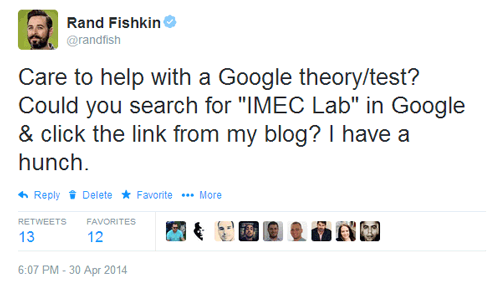For a long time, folks in the search, technology, and marketing worlds have surmised that Google is using query and clickthrough data to bias search result rankings. I recently observed several examples of this via some industry colleagues (that, unfortunately, I cannot share publicly), and thought, “what the heck, let’s give it a spin.” On April 30th, at 6:03pm Pacific, I performed the following query:
A blog post I’d published last week ranked number 7 in Google US results (incognito/logged-out, without regional geographic bias), the same as it had a week prior just after I wrote it (sadly, I forgot to take a screenshot last week when I first looked at the ranking). After noting the position and taking a screenshot, I sent this tweet:

Over the next few hours, people on Twitter took action, and responded back. And then something fascinating happened:

I’d estimate between 175-250 people likely saw the tweet and took action (though it’s hard to know that number for certain). The blog post itself received 228 visits from Google on April 30th, and I’d guess that the majority of these came from the tweet. To compare, on April 29th (the prior day), traffic from Google search accounted for a mere 7 visits to the page.

By the time I checked again (at 9:01pm Pacific), I saw the same thing folks on Twitter were reporting. The page in question had moved up to the 1st position (at least in non-personalized, non-region-specific US results):

Let’s be clear – this is not enough evidence to say for certain that Google is definitively using query and click volume to rank webpages. There may be other factors at work. The page could have coincidentally (or as a result of the tweet) received new links or other signals that caused Google to change the ranking position from where it sat over the prior week. It’s also possible that the boost will be extremely temporal. And it’s certainly the case that the rankings are geographically diverse. I looked at results in Canada (currently #9), Australia (currently #7), New Zealand (currently #6), the United Kingdom (currently #8), South Africa (currently #6), and Ireland (currently #8). My suspicion is that because the vast majority of the searches and clicks came from the US, that’s the only geography where the modified ranking is observable (but this is merely a guess).
But, those caveats noted, it’s enough to convince me that further testing is warranted, and that queries and clicks may be a more direct and more directly observable factor (particularly in long-tail, rarely-searched-for queries like this one) than I’d previously thought.
If you’re interested in helping me test stuff like this in the future, please do check out my testing project group, which is designed for just this sort of thing 🙂
